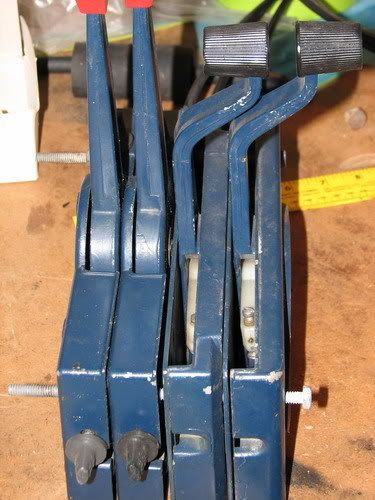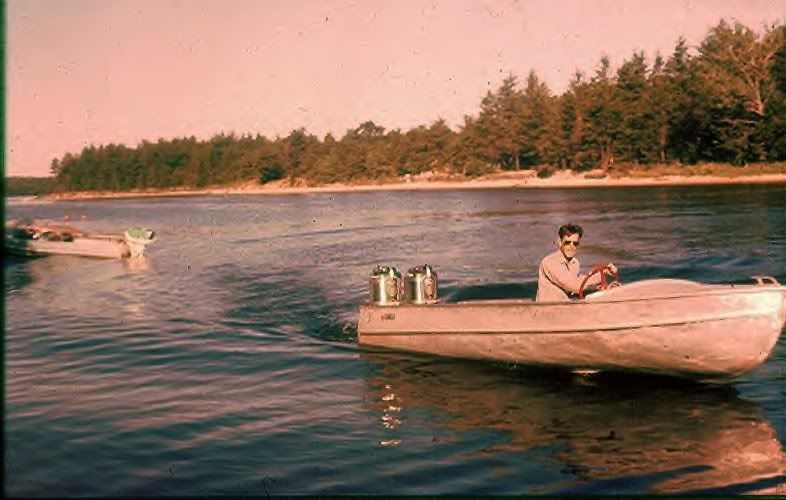Re: I know I am crazy! twin 20hp's on 14' row
The entire point of having a boat is to have some fun. If your idea of fun is to set up and use a twin motor installation, go for it. There are, however, some things to think about so you will be able to operate in a safe and practical manner.
First, what is the maximum horsepower rating for the boat? If it is under 40hp, you will have to consider the risk factors. The Coast Guard and/or marine patrol want to see engines within the hp applicable to the boat but I have been told by senior members of Wildlife and Fisheries in my state, who have an enforcement role in boating, that it is not illegal to exceed the ratings. The problem in doing so lies in the "what happens if," should you be involved in an accident. This can be an issue if your boat is insured too because your insurance company will be looking for ways to avoid a claim.
You must assemble a safe and practical steering system. There is no reason why you can not use an older style pully/cable system if you make sure it is in top shape. I know that folks these days claim that this is blasphemy but the vast majority of the boating public managed to use them for many, many years successfully. The key is in the proper setup and maintenance of the system. BTW, these systems were used for motors much larger than what you have and they were used for twin engine installations too. If you surf Ebay, you may find the standard, OMC link that was used between the motors. You can also use a dual drum push/pull type steering system with a pair of tube bracket/tie arm assemblies as shown below. Whether this option will work or not depends largely on whether you end up with enough room in a transverse direction across the transom for the push pull rods to have full range of travel.

The next issue is boat stability. If you do this setup, test the boat slowly and progressively. Start out operating slowly and make some turns, etc. Keep doing this at progressively higher speeds and make minor heading changes as you test the handling characteristics. Do the testing in a variety of wind/water conditions too. If all goes well, you will know that the boat is relatively safe with this installation.
As mentioned, engine weight is a concern but may not be that big a deal. If the boat is rated to handle something like an OMC Super Quiet 40hp (the one with the "fat" midsection), there won't be much difference in transom weight because your motors only weigh about 85 - 90 pounds each. You can compensate by forward steering and battery placement. While I wouldn't put fuel in the back of the boat, placing it all the way forward is of marginal value and may even be undesirable because, as you deplete it, the CG of the boat will shift in a rearward direction. I prefer to keep my fuel tanks midships for this reason.
You must find a duel control unit or make one. I made one out of two stock Evinrude/Johnson Shipmaster units. The pics below show how I did it. Notice that the raised mouldings on the outer box of one assembly had to be ground down to a flat surface in order to mount the second gear shift box outside of it. You also have to install the two flat plates that come with the stock single control boxes, between each gear shift box and the unit next to it. If you don't the gear shift handles won't move freely. Notice also that two of the throttle/shift handles have been removed and reversed. In order to prevent excess cable from causing clutter, I purchased my cables in different sizes, with an extra foot in length for each cable as it moved further from the starboard side of the boat. Finally, be aware that this vintage of the controls came in two versions - the ones that accepted cables with set screws and the later ones in which the cables had press fit ends. Some of the internal parts for the control boxes are different for each setup. You can still mix the types but you will have to get the correct cables for each type.




My biggest concern with your setup is the relatively small amount of "dry" freeboard you will have at the transom. If you are stopped or moving slowly in a following sea, this will cause the transom to be overtopped quite easily. I recommend building a self draining splashwell, coupled with a high capacity bilge pump and a substantial battery to power it frequently. If the splashwell does its job, the bilge pump shouldn't come into play but it is good to have it as a backup.
If you can do this installation safely, I don't see any reason why you shouldn't. You will burn more fuel than a single engine of equal horsepower, and your maintenance costs will be higher, but those things need not be an issue if you're comfortable with them. I had a pair of 1958 Evinrude "Bigtwin" 35hp motors on a 15' trihull for awhile and used it extensively - it worked just fine.
 but its a good crazy.
but its a good crazy.
























